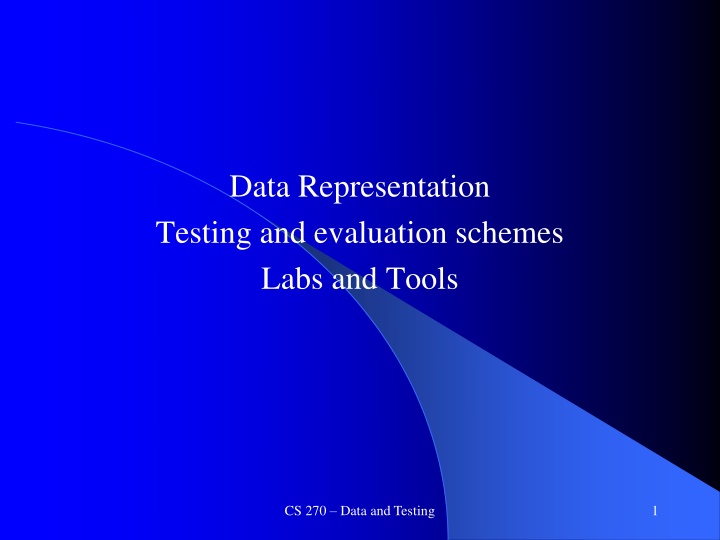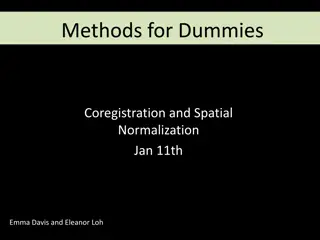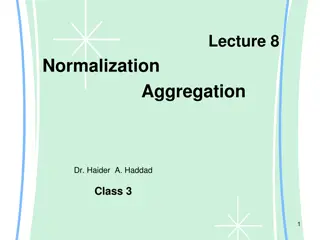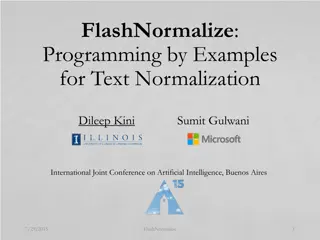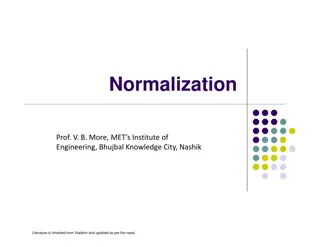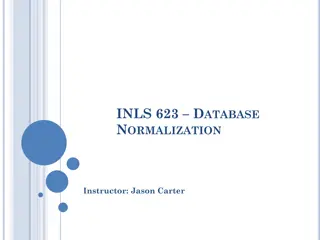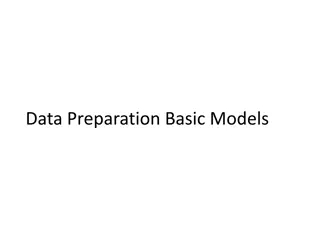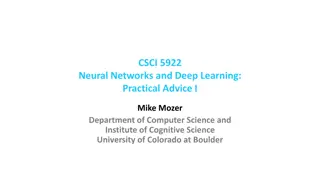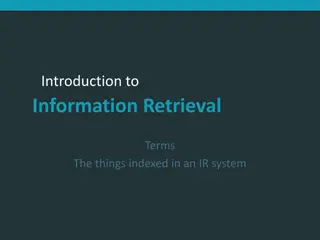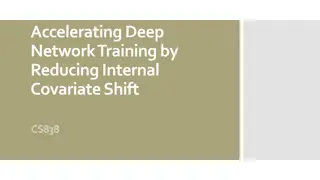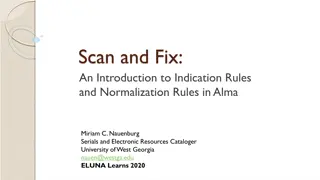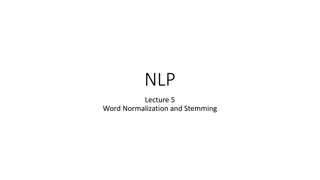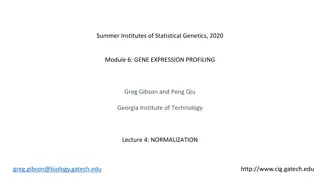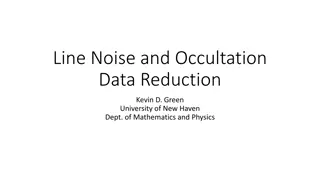Exploring Data Representation and Normalization Techniques
Explore different data representation, testing, and evaluation schemes along with fitting data to models and normalization techniques. Understand the importance of representing features for classification and regression tasks. Learn to normalize data between 0 and 1 and handle astronomical input features in machine learning tasks.
Download Presentation

Please find below an Image/Link to download the presentation.
The content on the website is provided AS IS for your information and personal use only. It may not be sold, licensed, or shared on other websites without obtaining consent from the author.If you encounter any issues during the download, it is possible that the publisher has removed the file from their server.
You are allowed to download the files provided on this website for personal or commercial use, subject to the condition that they are used lawfully. All files are the property of their respective owners.
The content on the website is provided AS IS for your information and personal use only. It may not be sold, licensed, or shared on other websites without obtaining consent from the author.
E N D
Presentation Transcript
Data Representation Testing and evaluation schemes Labs and Tools CS 270 Data and Testing 1
Data Set Features Data Types Nominal (aka Categorical, Discrete) Continuous (aka Real, Numeric) Linear (aka Ordinal) Is usually just treated as continuous, so that ordering info is maintained Consider a Task: Classifying the quality of pizza What features might we use? Do one of each versions above. How to represent those features? Will usually depend on the learning model we are using Classification assumes the output class is nominal. If output is continuous, then we are doing regression. CS 270 Data and Testing 2
Fitting Data to the Model Continuous -> Nominal Discretize into bins more on this later Nominal -> Continuous (Perceptron expects continuous) a) One input node for each nominal value where one of the nodes is set to 1 and the other nodes are set to 0 One Hot Can also explode the variable into n-1 input nodes where the most common value is not explicitly represented (i.e. the all 0 case) b) Use 1 node but with a different continuous value representing each nominal value c) Distributed logbn nodes can uniquely represent n nominal values (e.g. 3 binary nodes could represent 8 values) d) If there is a very large number of nominal values, could cluster (discretize) them into a more manageable number of values and then use one of the techniques above Linear data is already in continuous form CS 270 Data and Testing 3
Data Normalization What would happen if you used two input features in an astronomical task as follows: Weight of the planet in grams Diameter of the planet in light-years CS 270 Data and Testing 4
Data Normalization What would happen if you used two input features in an astronomical task as follows: Weight of the planet in grams Diameter of the planet in light-years Normalize the Data between 0 and 1 (or similar bounds) For a specific instance, could get the normalized feature as follows: fnormalized= (foriginal - MinvalueTS )/(MaxvalueTS- MinvalueTS ) Use these same Max and Min values to normalize data in novel instances Sklearn has methods to do this and other normalization approaches Note that a novel instance may have a normalized value outside 0 and 1 Why? Is it a big issue? CS 270 Data and Testing 5
ARFF Files An ARFF (Attribute-Relation File Format) file is an ASCII text file that describes a Machine Learning dataset (or relation). Developed at the University of Waikato (NZ) for use with the Weka machine learning software (http://www.cs.waikato.ac.nz/~ml/weka). We will commonly use the ARFF format for CS 270 ARFF files have two distinct sections: Metadata information Name of relation (Data Set) List of attributes and domains Data information Actual instances or rows of the relation Optional comments may also be included which give information about the Data Set (lines prefixed with %) CS 270 Data and Testing 6
Sample ARFF File % 1. Title: Pizza Database % 2. Sources: % (a) Creator: BYU CS 270 Class % (b) Statistics about the features, etc. @RELATION Pizza @ATTRIBUTE Weight @ATTRIBUTE Crust @ATTRIBUTE Cheesiness @ATTRIBUTE Meat @ATTRIBUTE Quality real {Pan, Thin, Stuffed} real {True, False} {Good, Great} @DATA .9, Stuffed, .1, Thin, ?, Thin, .6, Pan, 99, 2, 60, 60, True, False, True, True, Great Good Good Great Any column could be the output, but we will assume that the last column(s) is the output Assume cheesiness is linear (an integer between 0 and 100) What would you do to this data before using it with a perceptron and what would the perceptron look like? Show an updated ARFF row CS 270 Data and Testing 7
ARFF Files More details and syntax information for ARFF files can be found at our website Also have a small arff library to help you out Data sets that we have already put into the ARFF format can also be found at our website and linked to from the LS content page http://axon.cs.byu.edu/data/ You will use a number of these in your simulations throughout the semester Always read about the task, features, etc, rather than just plugging in the numbers You will create your own ARFF files in some projects, and particularly with the group project CS 270 Data and Testing 8
Performance Measures There are a number of ways to measure the performance of a learning algorithm: Predictive accuracy of the induced model (or error) Size of the induced model Time to compute the induced model etc. We will focus mostly on accuracy/error Fundamental Assumption: Future novel instances are drawn from the same/similar distribution as the training instances CS 270 Data and Testing 9
Training/Testing Alternatives Four methods that we commonly use: Training set method Static split test set Random split test set CV N-fold cross-validation The last two are the more accurate approaches CS 270 Data and Testing 10
Training Set Method Procedure Train model with the training set Compute accuracy on the same training set Simple but least reliable estimate of future performance on unseen data (a rote learner could score 100%!) Not used as a performance metric but it is often important information in understanding how a machine learning model learns This is information which you will often report in your labs and then compare it with how the learner does with a better method CS 270 Data and Testing 11
Static Training/Test Set Static Split Approach The data owner makes available to the machine learner two distinct datasets: One is used for learning/training (i.e., inducing a model), and One is used exclusively for testing Note that this gives a way to do repeatable tests Can be used for challenges (e.g. to see how everyone does on one particular unseen set, method we use for helping grade your labs.) Be careful not to overfit the Test Set ( Gold Standard ) CS 270 Data and Testing 12
Cross-Validation (CV) Cross-Validation (CV) Cross-validation is a resampling method that uses different portions of the data to test and train a model on different iterations We then average the results of these iterations With CV we avoid having data only used for either training or test, and give all data a chance to be part of each, thus getting more accurate results CS 270 Data and Testing 13
Random Training/Test Set Approach Random Split CV Approach (aka holdout method) The data owner makes available to the machine learner a single dataset The machine learner splits the dataset into a training and a test set, such that: Instances are randomly assigned to either set The distribution of instances (with respect to the target class) is hopefully similar in both sets due to randomizing the data before the split Stratification is an option to ensure proper distribution Typically 60% to 90% of instances is used for training and the remainder for testing the more data there is the more that can be used for training and still get statistically significant test predictions Once is rarely enough. Could get a lucky or unlucky test set Do multiple training runs with different random splits and average the results to get a more statistically accurate prediction of generalization accuracy. CS 270 Data and Testing 14
N-fold Cross-validation Use all the data for both training and testing More structured than the random train/test split approach Each instance is tested exactly once and used for training N-1 times Procedure Partition the randomized dataset (call it D)into N equally- sized subsets S1, , SN For k = 1 to N Let Mk be the model induced from D - Sk Let ak be the accuracy of Mk on the instances of the test fold Sk Return (a1+a2+ +aN)/N CS 270 Data and Testing 15
N-fold Cross-validation Record test accuracy at each iteration and report the average CS 270 Data and Testing 16
N-fold Cross-validation (cont.) The larger N is, the smaller the variance in the final result Commonly, a value of N=10 is considered a reasonable compromise between time complexity and reliability Still must chose an actual model to use during execution how? CS 270 Data and Testing 17
N-fold Cross-validation (cont.) The larger N is, the smaller the variance in the final result Commonly, a value of N=10 is considered a reasonable compromise between time complexity and reliability Still must chose an actual model to use during execution - how? Should we select the one model that was best on its test fold? All data! With any of the approaches we have presented Note that N-fold CV is just a better way to estimate how well we will do on novel data, rather than a way to do model selection CS 270 Data and Testing 18
Machine Learning Tools Lots of new Machine Learning Tools Weka was the first main site with lots of ready to run models Scikit-learn now very popular Languages: Python with NumPy, matplotlib, Pandas, other libraries R (good statistical packages), but with growing Python libraries Deep Learning Neural Network frameworks GPU capabilities Tensorflow - Google PyTorch Multiple developers (Facebook, twitter, Nvidia...) - Python Others: Caffe2 (Facebook), Keras, Theano, CNTK (Microsoft) Data Mining Business packages Visualization, Expensive Great for experimenting and applying to real problems But important to get under the hood and not just be black box ML users CS 270 Data and Testing 19
Doing Your Labs We will use scikit-learn for individual labs Whatever you want in group project Program in Python in Jupyter notebooks NumPy library Great with arrays, etc. Recommended tools and libraries Colab Google IDE for Python and Jupyter notebooks Pandas Data Frames and tools are very convenient MatplotLib CS 270 Data and Testing 20
scikit-learn (SK) One of the most used and powerful machine learning toolkits out there Lots of implemented models and tools to use for machine learning applications Sometimes missing some things we would like, but it is continually evolving Source is available, and you can always override methods with your own, etc. Basically a Python Library to call from your Python code Familiarize yourself with the scikit-learn website as you will be using it for all labs CS 270 Data and Testing 21
Perceptron Project Content Section of LS (Learning Suite) for project specifications Review carefully the introductory part regarding all projects For each project carefully read the specifications for the lab in the Jupyter notebook on GitHub You can just copy the Perceptron notebook from the GitHub site to your computer and then add your work in the code and text boxes CS 270 Data and Testing 22
